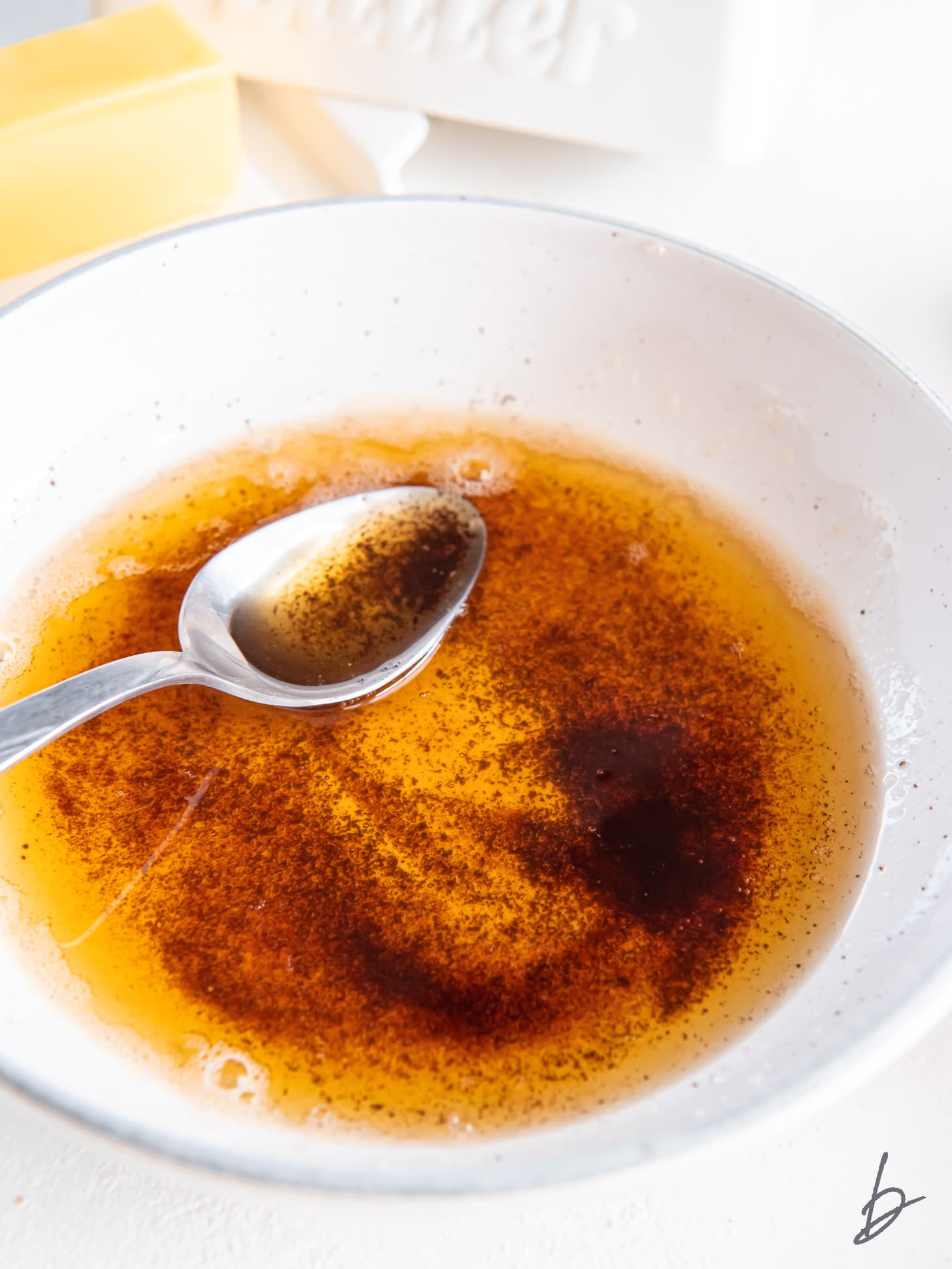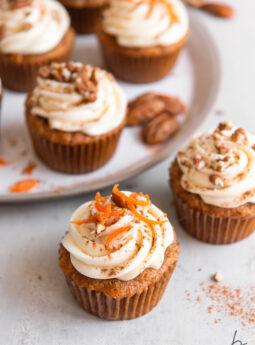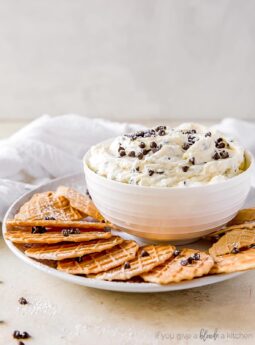How to Make Brown Butter
Elevate your baking and learn all the tips and tricks to browning butter. This unique ingredient has a one-of-a-kind flavor that is a treat for the tastebuds. Use it in chocolate chip cookies, banana bread or add it to icing!

I’m expanding my Better Your Baking series and ramping up the tips and tricks to help you become the best home baker you can be! Today we’re perfecting how to make brown butter. This delicious ingredient adds a depth of flavor for various desserts. Perfecting this browning method is simple, but there are definitely some tricks you need to know!
What Is Brown Butter?
Brown butter, also known as beurre noisette, is a sauce that can be used in baked goods as well as savory dishes. Its nutty scent and caramel-like flavor is a delight for the tastebuds!
The butter is melted on the stovetop until the milk solids separate and begin to brown. This process, called the Maillard reaction, is the breakdown of proteins into different flavor compounds.
Ingredients and Equipment
- Butter is the star! Use a good-quality, unsalted butter. In almost all recipes, the salt is added separately so unsalted butter is preferred. The higher quality butters have less water content and more fat, which yields more flavor.
- Use a light-colored pan or skillet with a heavy bottom. The lighter color makes it easier to see when the butter is browning. In a dark-colored pan, you can’t see the color change as easily and the butter is at risk of burning.
Recipe Variations
Add the herbs or spices. As the butter browns, add some sage, thyme, rosemary sprigs or cinnamon sticks. When the butter is done, discard the herbs or spices or use them in your recipe.
Toast some nuts. If your recipe calls for nuts, consider toasting them in the brown butter. Pecans, almonds, walnuts or macadamia nuts nicely complement the flavor.
Add some sweetness. Stir in 1 to 2 teaspoons vanilla extract or honey. You can also add 1 Tablespoon maple syrup if you desire. This will add a warm, sweet aroma.
How to Make Brown Butter

- Place butter pieces in a light-colored pan. Bring to medium heat and stir constantly with a rubber spatula or gently swirl the pan. Keep the butter moving so it melts evenly and doesn’t burn.
- The butter will melt, then it will start to foam up.
- The foam will subside and the butter will start to brown. Once you see a few tiny brown flecks and the butter has a caramel-like scent, remove it from the heat and immediately transfer to a heatproof bowl.
- Let the butter cool slightly before using it in desired recipe.
Brown vs. Burnt Butter
Using your senses is key to prevent burning your brown butter. You’ll smell a sweet, nutty aroma when the butter is done. Once you see a golden brown color and a few specks are turning dark brown, remove the butter from the pan and pour it into a heatproof bowl. The butter will continue to cook as it cools. Taste it to see if it has its characteristic caramel-like flavor.
If the bottom of the pan has a bunch of black specks, then the butter is burnt. You will also smell a burnt scent. Unfortunately, the butter is no longer salvageable since the unique flavor is gone.

Expert Tips
Cut the butter into equal size pieces. I usually use one stick (1/2 cup) of butter and cut it into tablespoons (8 pieces). This helps the butter melt at the same rate.
Use a light-colored pan so you can see the color of the butter as it melts. This also helps prevent it from burning. Stir the butter frequently. You can do this by using a whisk, rubber spatula or simply by swirling the pan. Again, this is a preventative measure to prevent burning and consistent cooking.
Use your senses! You can smell the butter browning before you can see it. The nutty aroma is a tell-tale sign that the brown flecks are about to appear. Once they appear, you can try tasting the brown butter (careful it’s hot!) It should have a caramel-like taste.
Have your heatproof bowl ready so you can remove the brown butter from the heat as soon as it’s finished. You don’t want to keep it in the pan otherwise it will burn. Even if it’s off the heat, the pan is still hot.
Substituting Brown Butter in Recipes
Brown butter may be substituted in a variety of recipes that call for melted butter. However, you need to account for the loss of water that happened when the butter was cooking. Yes, there’s water in butter and it evaporates when you make brown butter. One stick of butter reduces to about 80% of its original weight after it’s browned.
As a general guideline, for every stick of butter, add 1 1/2 Tablespoons of water to the recipe. I usually just stir it into the brown butter after it has cooled a bit.
Storage Tips
Storage: Place melted brown butter in an airtight container and store in the refrigerator for up to two weeks. It will solidify, so be sure to melt in again before using.
Freezing: Brown butter will keep in an airtight container in the freezer for up to 3 months. Bring to room temperature before melting and using in a recipe.
Frequently Asked Questions
Yes, simply put it in a pan on the stovetop over low heat or microwave it on 50% power level. Stir frequently so it melts evenly.
No. It’s non-dairy and does not have milk solids, which is what provides the flavor in brown butter.
Yes and no. If your recipe already calls for brown butter, then it is likely that the recipe developer already accounted for texture. However, if you’re substituting with brown butter and don’t account for the evaporation of water, then your baked goods may turn out dry.
The specks are milk solids that have been toasted. They hold a lot of flavor so scrape them out of the pan with the melted butter.
No, it’s not necessary to strain out the brown flecks. However, if you are making a frosting or icing, I suggest straining the brown butter through a cheese cloth. Getting rid of the flecks will make for a smoother consistency.

Related Recipes to Try
Now that you’ve perfected browning butter, try using it in chewy chocolate chip cookies for a subtle nutty taste or in a glaze on banana bread donuts. You can also use it for the filling in cinnamon rolls or frosting on cupcakes!
The nutty flavor also complements dessert bars, such as blondies and magic cookie bars. In short, it complements any recipe that uses nuts, like my maple pecan cookies.
Other ways to use it include pouring it over waffles, stirring it in with pasta or adding it to granola. It also works well as a glaze or sauce for meat and vegetables.
Did you love this recipe? Please leave a 5-star 🌟🌟🌟🌟🌟 rating in the recipe card below and if you REALLY loved it, consider leaving a comment further down the page.

Get the Recipe: How to Make Brown Butter
Ingredients
- ½ cup (8 Tbs) unsalted butter, cut into tablespoons
Instructions
- Place butter pieces in a light-colored pan. Bring to medium heat and stir constantly with a rubber spatula or gently swirl the pan. Keep the butter moving so it melts evenly and doesn’t burn.
- The butter will melt, then it will start to foam up. The foam will subside and the butter will start to brown. Once you see little brown flecks and the butter has a nutty aroma, remove it from the heat and immediately transfer to a heatproof bowl.
- Let it cool in the bowl before using in desired recipe or storing for later.










